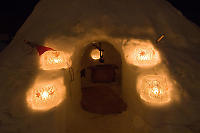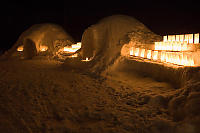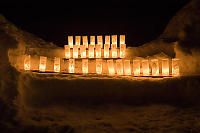
Gifu

 Love those traditions
Love those traditions

Driving from
Nagano
to Gifu, you would think you were in Canada. Lots of tall snowy
peaks, tree lined rivers and narrow winding roads. A few things
are different - our ski resorts tend to be large multiple lift projects
whereas in Japan there are lots of ski hills with just a single lift
and a handfull of runs. Driving through the mountains you will
pass several different (small) ski hills in an hour. We weren't
really here for the skiing (the long drought of fresh snow made most of
the mountains pretty empty), but when we saw waterfall lookout and hot
spring foot spa, we had to pull over for a visit.
Takayama

Takayama was a pleasant surprise for
me.
It's a city, but not
huge (mostly low rise buildings). It's quite walkable and in the
downtown area you find lots of shopping. We found a street of
traditional buildings where the local food and woodworking (and sake)
figured
prominently. Sadly, I really didn't do a good job capturing the
charm of Takayama. Helen thinks it has something to do with all
of the sake tasting I was doing.

The central area of Takayama has a river
dividing it. Closest to the river (which is sadly completly bound
by concrete) is a pedestrian walk way. The road closest is used
by a morning market and the street past that is tourist shopping.
In this area you will find sculpture and signs to tell you some history
of the area. I was taken by the wildlife - ducks on the
river, carp in the river and it was a pretty even match when people
started dropping crumbs in. A surprise for me was the kingfisher
- that would be rare for a Canadian city so I was impressed to see one
perched downtown here.
This was quite a productive shopping area for us - Mark and Helen both
purchased local wood carvings. We dined on local snacks as much
as we could (really good crackers for instance), but there is only so
much you can do when your accomodations is providing both breakfast and
dinner.
Shinhodaka Onsen
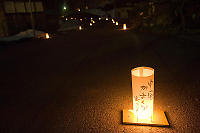
Shinhodaka Onsen was a lucky link from a
local web
site. Turns out this onsen (one of about 40 in the valley in the
middle of mountains) has a two week festival where they build igloos,
pound rice to make mochi and
just have a good time. Since it has a web page, they invited the
world world. Finding it was another thing all together - we wound
up deep in the mountains before we realized we need to ask for
help. We found a hotel that specialized in mountain treking
(never saw that on the internet) and amazingly they knew the place (it
wasn't close by. A bit more driving and we found the parking lot
(a hand full of cars) and in we went!
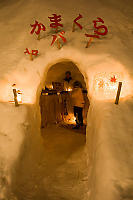
The igloos appear to be made with a front end
loader
(or some other big piece of machinery) that are then hollowed
out. Different igloos had different contents - one had a
barbeque, another had tea on the go. The temperature inside was
quite comfortable. Our favorite igloo was the "bar" igloo.
We met a local woman who could speak French and English and we chatted
over sake.
The local bartender (who was quite kind with the sake) had actually
visited Vancouver (his sister was learning English). He really
wanted to travel more, but not knowing english limited his prospects -
he was really happy to see that we had come to his part of the world.
Shirakawa-go
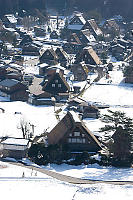
So imagine you live in a house in a valley a
long ways
away from most things. One day, the government comes by and
builds you a good road to the next big town, but also dams the river
and floods the valley up stream to create a power plant. Then the
government notices that the way you built your house (which is durrable
in the long hard winters) is rare and dissappearing so they make a your
village a national treasure. And register it with UNESCO.
And send about a million tourists a year by to come look at. What
would you do?
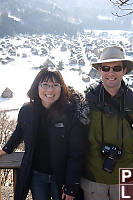
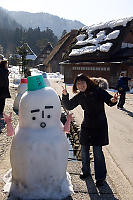
The answer is Shirakawa-go. This small
village
(which people really live in) is a massive tourist destination because
of how the Gassho houses are
built. Gassho, meaning "praying hands" after the steep sloped
roofs. The locals have adapted just fine -
most homes off 300 yen tours or lodging or food. The village is
setup well for the hordes of tourists (acres of bus parking for
instance) and there seems to be no shortage of jobs for locals.
But I have to say, it was a bit weird walking around where people live
taking pictures of their houses.
What you are really here to see is the roofs of these buildings.
The thick thatched roofs (made from pampas grass - not rice stalks)
keep the houses warm and dry in the winter. The steep pitch of
the roofs allow them to shed snow (and bear the burden of what stays
behind) from the heavy snowfall they encounter here. These roofs
are labour intensive to make (think how much easier it would be to just
have a tin roof), but if you have a whole valley of traditional homes,
you have a tourist attraction.
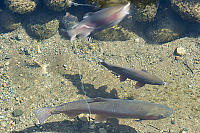

This village is set in the flat area
of the valley next to a river. There are several streams that run
through the village provides water for terraced rice farming.
Some of these homes are set next to flooded rice fields which can make
for some nice compositions. Some of the fields have carp living
in them and one stream had a rainbow trout. I was quite impressed
with how you can use such limited space for more than one type of food
production.
Sadly the village is now mixed structures - many traditional, but some
modern houses are mixed in. Power lines are sadly common (I'm not
saying live without them, but why not run them underground?).
That said, it was still worth the trip out to see it.
We drove back to Takayama to our next Ryokan. This Ryokan is set
in an Gassho style house that was relocated from another part of Japan.
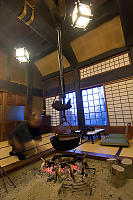
Our dinner was served in the old home part of
the
building, some of it cooked on the charcoal fire in the middle of the
room. The fire doesn't have a dedicated chimney so the room has a
bit of a smokey haze.
Hida Village
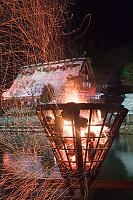
I am the first person to admit we made some
mistakes
in how we planned this trip to Japan. We knew we wanted winter
scenery and found that the end of January to early February is the best
time. We were just unlucky that we happened to go in an
unseasonably warm year. What we did wrong was missing the
festivals. Local festivals are hard to find and generally only
happen for a day or two a year. Even special events (like the
light show at Shirakawa-go) only happens a few nights a year.
Ideally, you would put these events in your itenerray and then plan
your travels around that. We didn't. Because we missed so
many festivals (often by just days), I was really happy to stuble into
the Hida Village light up. The Hida Village is a tourist trap -
these homes were moved here to create a museum showing how life
was. It also happened to be
just down the road from our hotel and had a light up event in the
evening. Somehow this didn't show up on the tourist radar and for
300 yen we almost had the place to ourselves. I was quite happy.
Most of these homes are setup as museums showing the space families
lived in. Most of the homes have an integrated barn for instance
so animals can be brought in at night. Some of the larger houses
had a space for a silkwork factory in the upper levels of the
house. There was a demonstration house showing how silkworms
would be kept (temperature sensitive), fed and harvested. The
silk would then be used to make clothing and goods to be traded.
Not every house that is open durring the day is open at night, but
enough was that we made a good evening out of it.
The next morning we packed up our beloved car (by this point we had put
more than on thousand km on it) and returned it near the train
station. We picked up some express tickets to Nagoya and then
shinkansen tickets to
Kyoto.
Tags: Japan(19), snow(8), house(5), field(3), fire(2), drink(2)
People: Helen(2), Mark(1)
From: John Harvey Photo > Trips out of the Country > A Fourth Trip to Japan > Gifu
From: John Harvey Photo > A Fourth Trip to Japan > Gifu
I just discovered your www site, and am really enjoying it. Hope to see you this summer.
Anne Heppner-Friesen
Thursday, May 7th, 2009 at 09:17:19
Last Modified Saturday, January 21st, 2023 at 23:47:44 Edit
Copyright and Contact Information.

 Love those traditions
Love those traditions

 Love those traditions
Love those traditions




